Summary
- Asian stocks fell in September, with concerns about China’s growth outlook and the US Federal Reserve (Fed)’s taper plan being the key drivers of sentiment. For the month, the MSCI AC Asia ex Japan Index declined by 4.2% in US dollar (USD) terms.
- North Asia broadly underperformed as the China Evergrande debt crisis roiled markets. Appearing to follow in China’s footsteps, South Korean lawmakers made moves to tighten regulations on internet firms. Market sentiment in Taiwan was affected by the power rationing in some Chinese provinces where Taiwanese electronics and semiconductor companies have factories.
- India edged higher by 0.6% in USD terms, as the nation appeared to be emerging from its severe second wave of COVID-19. Indonesia, which rose by 3.4% and was the only other market to post a positive return, was buoyed by parliamentary approval of a USD 190 billion state budget and its exports reaching a record high in August.
- We continue to lean on our disciplined bottom-up stock picking approach to navigate these uncertain conditions, with a strong preference for companies undergoing structural positive changes and sustainable returns.
Market review
Regional equities decline in September
Asian stocks fell in September. Concerns about China’s growth outlook were a key driver of sentiment, as the China Evergrande debt crisis and power outages across many of the country’s manufacturing hubs dominated headlines over the month. Elsewhere, the US Federal Reserve (Fed) hinted that it could moderate its asset purchases as soon as November and stated that half its policymakers now expect an interest rate hike in 2022.
For the month, the MSCI AC Asia ex Japan Index fell 4.2% in US dollar (USD) terms. North Asia and Thailand were the biggest laggards, while Indonesia and India were the only markets to post positive USD returns in September.
Chart 1: 1-year market performance of MSCI AC Asia ex Japan versus Emerging Markets versus All Country World Index
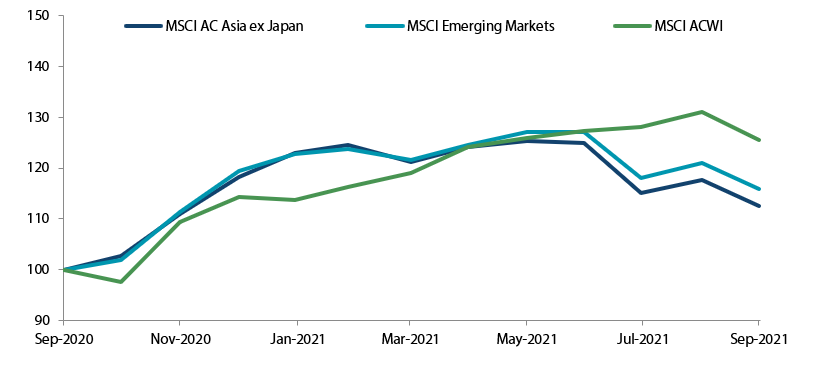 Source: Bloomberg, 30 September 2021. Returns are in USD. Past performance is not necessarily indicative of future performance.
Source: Bloomberg, 30 September 2021. Returns are in USD. Past performance is not necessarily indicative of future performance.
Chart 2: MSCI AC Asia ex Japan versus Emerging Markets versus All Country World Index price-to-earnings
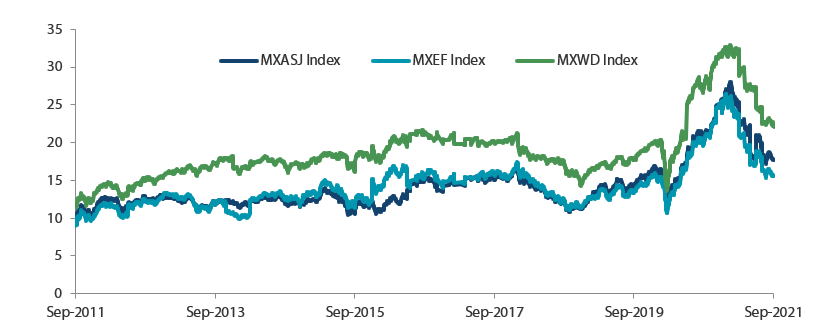 Source: Bloomberg, 30 September 2021. Returns are in USD. Past performance is not necessarily indicative of future performance.
Source: Bloomberg, 30 September 2021. Returns are in USD. Past performance is not necessarily indicative of future performance.
North Asia broadly underperforms
China (-5.0% in USD terms), Hong Kong (-6.1%), South Korea (-6.6%) and Taiwan (-4.1%) all saw negative returns. News of real estate developer China Evergrande Group’s inability to finance its obligations roiled global markets. With more than USD 300 billion worth of liabilities, there were concerns that an Evergrande default could have knock-on effects on China’s property sector and financial system. China’s ongoing power shortage, which weighed on September manufacturing activity, also dampened sentiment.
In Hong Kong, casino and gaming stocks weakened after Macau’s surprise proposal for stricter controls on capital outflows and concern on Hong Kong developers being asked to perform national service. South Korea saw its biggest monthly decline since March 2020. Appearing to follow in China’s footsteps, the country’s lawmakers made moves to rein in internet firms with an antitrust probe against Kakao Corp and increased regulations for online platforms that advertise financial products.
Elsewhere, market sentiment in Taiwan was affected by the power rationing in some Chinese provinces where Taiwanese electronics and semiconductor companies have factories. That said, the central bank revised up Taiwan’s 2021 growth outlook to 5.75% from its previous forecast of 5.08%, on the back of strong exports.
India edges higher; ASEAN sees mixed returns
India edged higher by 0.6% in USD terms, as the nation appeared to be emerging from its severe second wave of COVID-19. The federal cabinet also approved a relief package for the country's cash-strapped telecommunications sector, which will allow mobile carriers to delay payments on their debt obligations.
The ASEAN region saw mixed returns. Indonesia (+3.4%) was the best performer in the region, buoyed by parliamentary approval of a USD 190 billion state budget and its exports reaching a record high of USD 21.42 billion in August. Singapore (-0.1%) and the Philippines (-1.9%) reimposed restrictions amid a spike in COVID-19 cases, while Malaysia (-3.7%) reached its target of fully vaccinating 80% of the adult population. Thailand (-7.1%) saw its stocks and currency weaken after it delayed plans to reopen its major cities to tourism, as its vaccination rates fell short of targets.
Chart 3: MSCI AC Asia ex Japan Index¹
| For the month ending 30 September 2021 | For the year ending 30 September 2021 | |
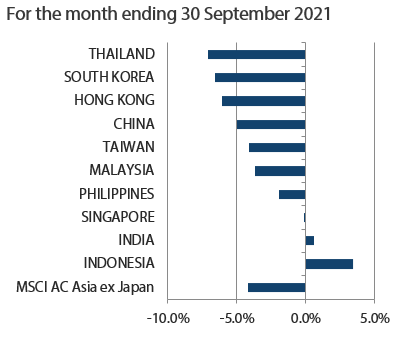
|
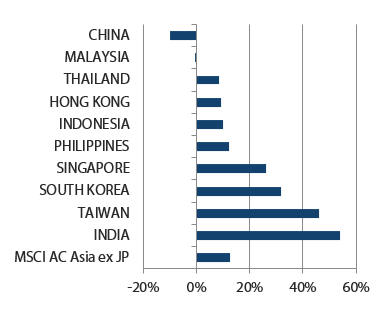
|
Source: Bloomberg, 30 September 2021
¹Note: Equity returns refer to MSCI indices quoted in USD. Returns are based on historical prices. Past performance is not necessarily indicative of future performance.
Market outlook
Leaning on disciplined stock picking approach to navigate uncertain macro conditions
Asia has endured several hurdles of late, from self-inflicted regulatory scrutiny in China to supply chain issues within technology to automobiles. This is now being coupled with monetary tightening in developed economies and rising energy prices. With the uncertain backdrop we continue to lean on our disciplined bottom-up stock picking approach to navigate these conditions, with a strong preference for companies undergoing structural positive changes and sustainable returns. In particular, the recent sharp market correction has thrown up buying opportunities in structural areas with policy support such as consumption, innovative healthcare, environment and areas of industrial technology.
Focus on environmental and industrial tech, software and innovative healthcare in China
While the market’s focus in China shifted rightly towards the most vulnerable property developers, we would again highlight that this is self-inflicted and part of the authorities’ efforts to shift from quantity of growth to an era of more sustainable and higher quality growth in the aim of “common prosperity”. Together with province-specific Delta variant breakouts, chip shortages and now power shortages, China’s economic growth is starting to slow more abruptly, and we would watch for signs of policy easing over the next few quarters. Accordingly, our investment focus continues to be firmly aligned with the objectives of the central party, namely in areas such as environmental and industrial tech, software and innovative healthcare. We continue to evaluate several potential new ideas in China where valuations have reached much more palatable levels.
More selective in South Korea and Taiwan
The never-ending global chip shortage issues which continue to plague a myriad of industries including automakers, have been a boon for some Taiwanese and Korean tech companies. The value of chipsets continues to be at an elevated level as supply remains constrained. Weaker outlook in PC memory and global tech industry competition ramping up in the form of sizeable tech supply chain investments in the US and China are headwinds to some industry bellwethers. Hence, with valuations in tech companies still not screaming cheap, we remain selective in hardware tech but continue to find attractive opportunities in content enablers, software, and niche integrated circuit design companies.
Monitoring valuations in India, positive on digital development in ASEAN
The Indian stock market has been notably resilient in this period of volatility across other markets. As the recovery gains traction following the country’s severe second COVID-19 wave, we see incrementally positive outlook commentary across our investment holdings. We are however cognizant that India is one of the more vulnerable economies in Asia to rising energy prices; as such, areas of the market with lofty valuations may become targeted for profit taking. We continue to see strong structural drivers in areas of real estate, private banks, new economy and healthcare.
As most of ASEAN continues to grapple with COVID-19 waves we would note this has dramatically accelerated digital development across these economies. There are also commendable efforts to expand renewable energy in countries such as the Philippines. These positive structural changes coupled with bottom-up investment ideas have led us to think that ASEAN could outperform for the first time in a number of years. Our positive views for the region remain concentrated in Indonesia, Philippines and Singapore for now.
Chart 4: MSCI AC Asia ex Japan price-to-earnings
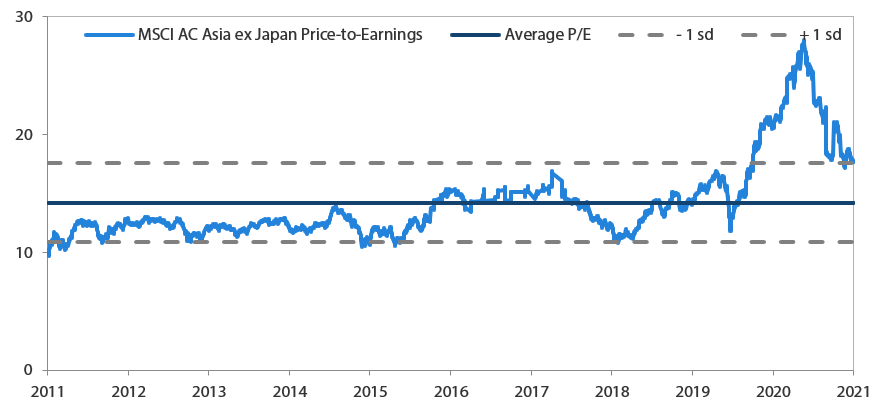 Source: Bloomberg, 30 September 2021. Ratios are computed in USD. The horizontal lines represent the average (the middle line) and one standard deviation on either side of this average for the period shown. Past performance is not necessarily indicative of future performance.
Source: Bloomberg, 30 September 2021. Ratios are computed in USD. The horizontal lines represent the average (the middle line) and one standard deviation on either side of this average for the period shown. Past performance is not necessarily indicative of future performance.
Chart 5: MSCI AC Asia ex Japan price-to-book
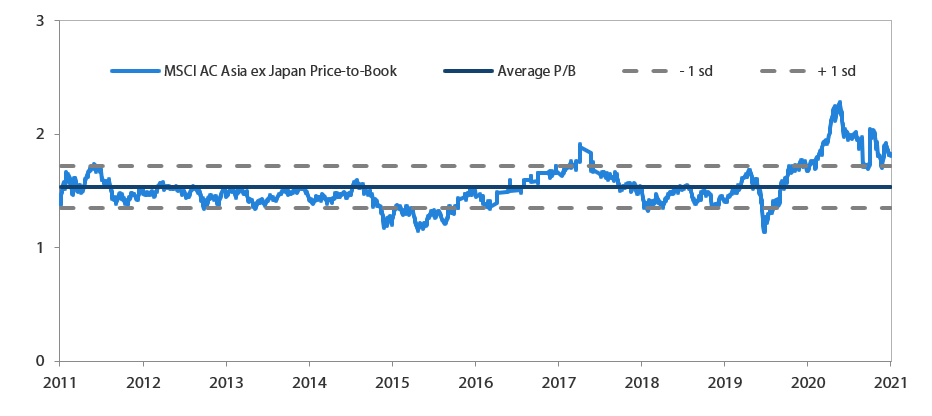 Source: Bloomberg, 30 September 2021. Ratios are computed in USD. The horizontal lines represent the average (the middle line) and one standard deviation on either side of this average for the period shown. Past performance is not necessarily indicative of future performance.
Source: Bloomberg, 30 September 2021. Ratios are computed in USD. The horizontal lines represent the average (the middle line) and one standard deviation on either side of this average for the period shown. Past performance is not necessarily indicative of future performance.




